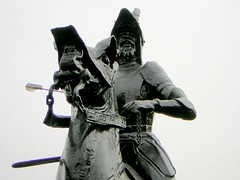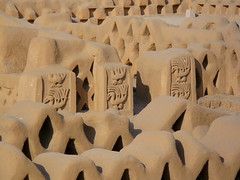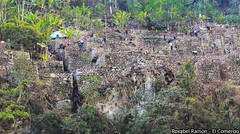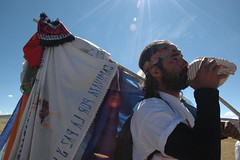Ruins of the Lurín Valley
Part of the Lima PreColombina series and the Explorando Lima series
There have been so many ancient cultures in Peru who have gone on to create so many citadels, farming terraces, temples and pyramids that you often only need to climb the nearest hill to find remnants of their existence. Because of this the vast majority of the country’s archaeological sites are relatively unknown, unvisited and unprotected.
The valley of the Lurin river is dotted with dozens of ruins starting from the ancient power-centre of Pachacamac up until the far inner reaches of the valley. The Cieneguilla region has many of these ruins and they are all really quite spectacular.

Behind the small town of Huaycán on the road east along the valley are the ruins of a city more than 1500 years old. After identifying several of these cities on Google Earth this was the one that Annett and I decided to attempt to reach first. Climbing up over the sandy foothills of the Andes through the backs of the illegally built houses of the poor we reached the top and were presented with a wonderful view. What was left of the pre-Inca city was spread out before us.
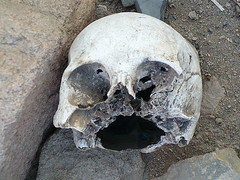 Across on the other side of the valley we climbed a much steeper cerro. At a point half way up we found a series of tombs. All were completely destroyed by tomb raiders who would have removed all the precious materials they could find, but the human bones that were of little value to them still remained.
Across on the other side of the valley we climbed a much steeper cerro. At a point half way up we found a series of tombs. All were completely destroyed by tomb raiders who would have removed all the precious materials they could find, but the human bones that were of little value to them still remained.
Below, among the ruins, were more fascinating finds. A wall with intriguing shapes unlike any I have seen in any other coastal ruins, a human skull still mostly intact and a large damaged pot.
The scale of the city was impressive, but what was more impressive is that there are several like it, and bigger, dotted along the valley. Back down towards the area of Cieneguilla known as La Curva, was were we visited another. This city, roughly the same size but in worse condition, proved just as interesting.
 As before it was not difficult to stumble across an ancient burial site. This one, with its skeleton also smashed by careless robbers held something more interesting than the bones themselves. Here large amounts of clothing and material that wrapped the body survived. Also mostly destroyed by careless robbers large enough pieces of the alpaca weaving remained intact to allow me to see the cross stitching and faded red dye.
As before it was not difficult to stumble across an ancient burial site. This one, with its skeleton also smashed by careless robbers held something more interesting than the bones themselves. Here large amounts of clothing and material that wrapped the body survived. Also mostly destroyed by careless robbers large enough pieces of the alpaca weaving remained intact to allow me to see the cross stitching and faded red dye.
Surrounding this city were many many collapsing farming terraces of the kind that can be seen all over the country.
Photos –
More from Explorando Lima.
Tags: adobe, explorando lima, lima precolombina, lurin valley, ruins, tombs





